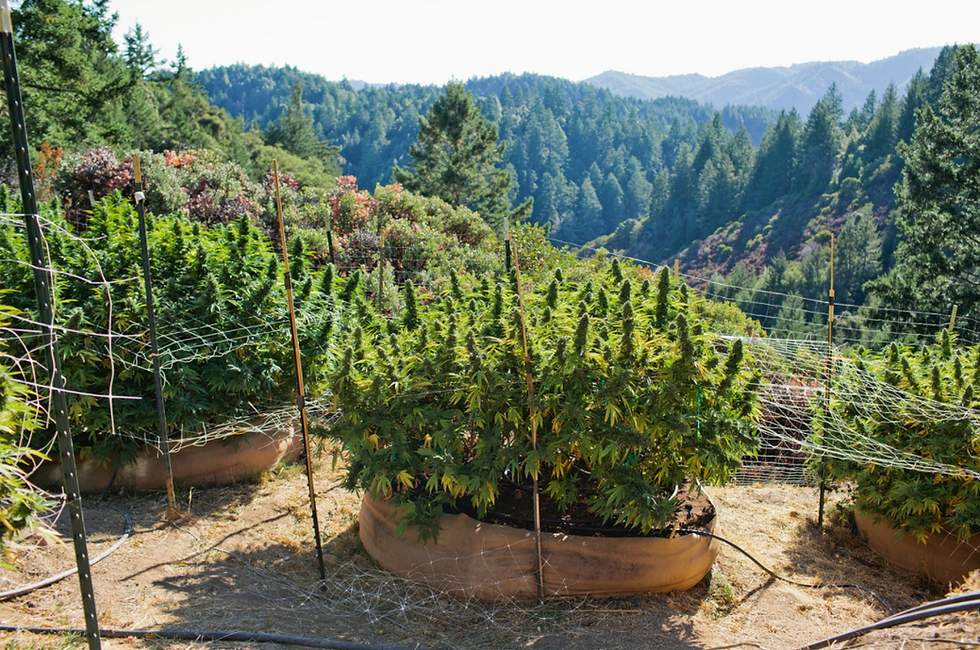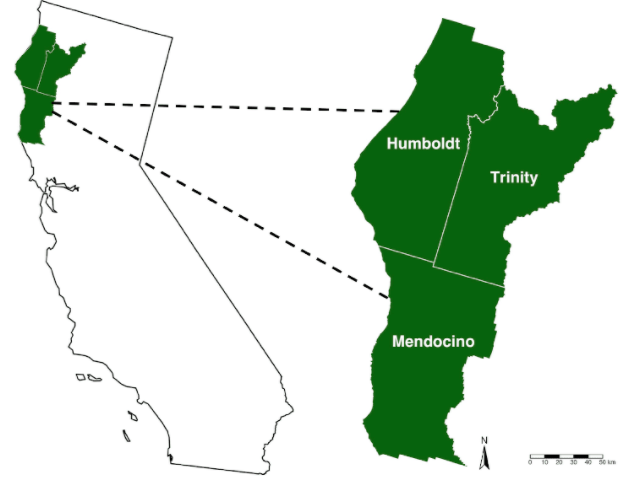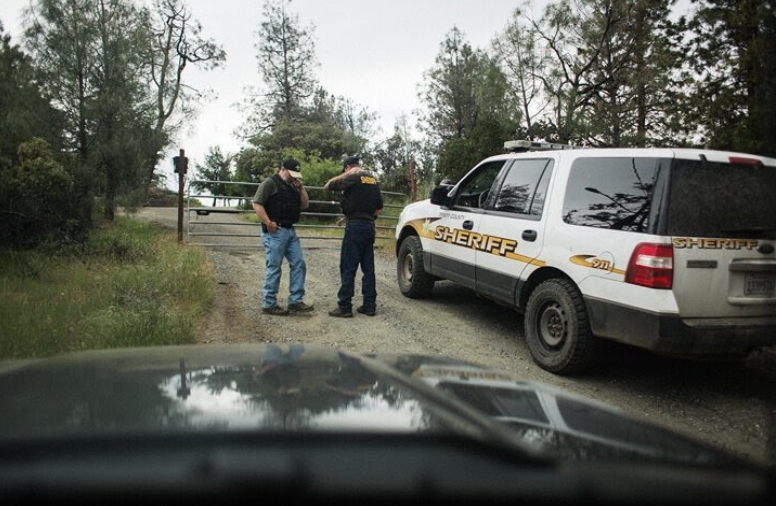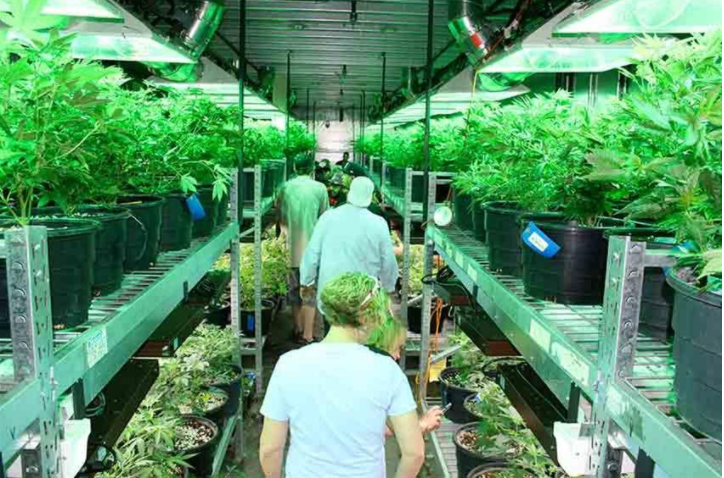
Growing up, I spent every summer on my cousin’s ranch in rural Trinity County, California. The ranch was my paradise, always crawling with kids catching crawdads, picking berries, and riding horses; blissfully removed from the tumult of the county as a whole. One particularly hot summer day, I couldn’t have been older than nine or ten, my uncle excitedly ushered us down the road to a point overlooking the valley below. Squinting against the sun, I stared in awe at the sky; a black helicopter was whipping through the air towards us. Like beetles, black-clad S.W.A.T. team members began to rappel into the gorge below. I was old enough to understand. This was Trinity County. This was a drug raid.
The ranch sits in the middle of Trinity County, somewhere between the misty redwood coasts and Mount Shasta further inland. Trinity, along with Humboldt and Mendocino Counties, comprise the Emerald Triangle, the nation’s largest marijuana producing region, turning out about 2 million pounds in 2020 alone. To the east lies Trinity, the most conservative and least populated of the three counties. South of Trinity, Mendocino stretches over miles of dense national forest and attracts some stragglers from the wealthier Napa Valley region nearby. Humboldt is the westernmost county in the Emerald Triangle, and as well as being the most populous, is undoubtedly the epicenter of production in the region. The northern coast ranges and Klamath Mountains provide the perfect climate to grow marijuana nearly year round. The rugged terrain is isolated and sparsely populated, with a population density of only 21 people per square mile, cowering in comparison to our statewide population density of 251. The far-removed, inaccessible nature of the region makes it a grower’s paradise, and it’s been just that since the 1960s. The national rise in demand for marijuana during the decade and the counter-cultural influences of the Bay Area caused the marijuana industry to flourish in the region. For more than half a century, marijuana farmers, often carrying on a multigenerational legacy, had operated under the same conditions and with the same expectations.

In 2016, Proposition 64 legalized marijuana in California. Supporters of this legislation often pointed to the economic benefits that legalization would bring; tax revenue from the newly regulated crop would make the state richer and stimulate declining economies in the Emerald Triangle. But how has the region changed since 2016? A sizable portion of the marijuana produced in the Emerald Triangle is still grown illegally. California State Department of Fish and Wildlife Chief David Bess told ABC7 that while some residents have abided by new licensing and legal codes, “there are a whole bunch of folks who are not.” In Humboldt, officials estimate that only one third of farmers have moved into the legal market. Licensing, regulations, and complicated legal hoops have caused the majority of growers to shy away from transitioning to growing legally.
The legal marijuana market also brings with it new economic hurdles that Humboldt residents apparently saw coming. In 2016, 60% of the voters in southern Humboldt County, the undisputed epicenter of the Emerald Triangle, voted against Proposition 64. Many of them cited the daunting 15% tax rate on marijuana and the steep licensing and permit fees as deterrents in joining the legal market. Transitioning into the legal market is an altogether different business for many; something purely agricultural transforms into something commercial. “There’s not a lot of participation in creating a local framework for a legal pot industry,” Rio Anderson, a farmer based out of Garberville in southern Humboldt, told the New Yorker. Regulations, branding, marketing, and competition with large corporations make the legal market unrecognizable to many seasoned growers. One caller into KMUD, Humboldt County’s local radio station, put it plainly: “the economy is bad here because [marijuana is] legal, and there’s big business getting into it.”

Herman, Talia, (2016, August 29) Trinity County Sheriff's Department Officers Brown and Hanover seek to cite an illegal marijuana operation in Trinity County.
Back in 2016, supporters of Proposition 64 cited the decline of black market activity as one of the main benefits of the legislation. But recent patterns in the Emerald Triangle reveal a different trend; many in the industry haven’t moved into the legal market and in turn have been forced further into the underground.
The black market for marijuana is a contributing factor to the high crime rates in the Emerald Triangle. Humboldt County has the highest missing persons rate in the state, with 717 people going missing per 100,000 each year. This figure is shocking, especially considering the statewide missing persons rate is just five per 100,000 people. Many of these missing persons cases can be tied to the marijuana industry. Lt. Dennis Young of the Humboldt County Sheriff's Office told the North Coast Journal that people who come to the area to work in the marijuana industry “oftentimes will not communicate with friends and family regarding their location, and/or they go off the grid for extended periods of time.” Linda Stansberry of the Journal called these cases “particularly hard to investigate,” citing the fact that others in the industry are often unwilling to cooperate with police.
“We were hoping that legalization [of marijuana] would push some of these people out, but it has not,” Humboldt County Sheriff William Honsal told the Ukiah Daily Journal, adding that the county is seeing, “unprecedented homicides and gun violence.” In September 2021, the California state government stepped in. In an effort to combat the high rates of violence in the Emerald Triangle, the state granted the region $1.5 million to help “eradicate large, unpermitted cannabis growing operations that… involve organized crime.”
Not only has the still-booming illegal market grown more dangerous, but Proposition 64 hasn’t generated the economic miracle in the Emerald Triangle that some predicted. According to the 2020 census, all three counties in the region have a poverty rate above 20%, classifying them as “poverty areas.” This figure stands in glaring contrast to the statewide poverty rate of just under 12%.
But marijuana tourism has generated tremendous revenue in other states since their legalization propositions have passed. Is, in the words of documentarian Josh Zeman, the Emerald Triangle becoming the “Napa County of cannabis?” In the five years since the passage of Proposition 64, the Emerald Triangle hasn’t seen a rise in the marijuana tourism that states like Oregon and Colorado have. Companies like Kush Tourism advertise dispensaries around the country and help individuals plan vacations with this specific purpose in mind. Unfortunately, dispensaries in the Emerald Triangle are few and far between, and the handful that exist are too far removed for the convenience of the average Californian.

Tourism through Colorado Cannabis Tours in Denver.
Where does this leave the region? On the outs. With the vast majority of operations still growing illegally, most growers not being in the economic position to transition into the legal market, the future isn’t looking cush for the Emerald Triangle.

Comments